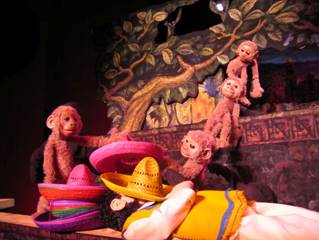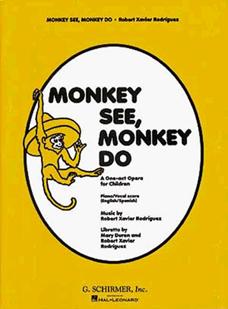Monkey See, Monkey Do (1987)
One-Act Opera for Children
Libretto (English and Spanish) by Mary (Duren) Medrick and the Composer,
based on a Mexican folk tale
Spanish translation by Josefina García
Duration: 35 minutes
Cast: 2S, Mz, T, Bar, B
cl/tpt/perc/gtr.acn.pf/vn.vc
Published Piano/Vocal score for sale
Recording available for rental for performances with puppets
Commissioned by the Dallas Opera
Premiere Performance: February 18, 1987; Dallas Opera; RXR, Conductor
Monkey See, Monkey Do (1986) is a delightful half-hour six-character chamber opera for children based on a traditional Mexican folk tale. An Opera America survey, published in Opera News,listed Monkey See, Monkey Do as the fourth most often-performed contemporary opera in America, with over 2000 performances throughout the United States, Canada and Mexico to date. The work was created for family audiences and may be toured with puppets, singing actors or both.
Hudson Vagabond Puppets, photo by Joy Magyawe
 Reviews:
Reviews:
…a stirring musical and visual treat. The score blends elements of Mexican-mariachi traditional folk melodies with the contemporary style of Mr. Rodríguez… The musical score encourages audience participation; the combination of English and Spanish is ideal for the introduction of language study; and the exposure to the Mexican culture fits perfectly into any humanities curriculum.
Stephen A. Rapp,
Opera Pacific
…marvelous…captivating and energetic work…an entire audience of young people will be eagerly rooting for the underdog to become the hero…Certainly a committed production of this work will ‘leave ‘em wanting more!
Mark Lynch, Opera for Youth
 Program Note:
Program Note:
The Mexican setting of Monkey See, Monkey Do is reflected in the music. The opera is scored for a typically Mexican mariachi-like ensemble. Violin, trumpet, guitar, and accordion are especially prominent. Several actual folk melodies are woven into the musical texture, among them a variation of the popular Chapanecas (Mexican Clapping Dance) and two strains from the celebrated El Jarabe Tapatio (Mexican Hat Dance). Other quoted melodies include two dance tunes associated with Antonio, the organ grinder (La Chilena Guerrense and Los Viejitos), and two love songs for Pedrito and Maria (La Mestiza and Preguntale a las Estrellas).
 Synopsis:
Synopsis:
A Mexican village square. Antonio frantically searches for his missing monkey. Maria and a trio of sympathetic villagers listen and try to help. Pedrito enters, wearing many sombreros piled upon his head. He tries to sell the sombreros, but the town people, more interested in Antonio's plight, rebuff him. Only Maria listens to Pedrito, and the two exchange tender words. The villagers leave to look for the monkey. Maria and Pedrito ask Antonio's permission to marry. Antonio refuses, calling Pedrito a failure. The organ grinder storms off to continue looking for the monkey. As Pedrito and Maria console each other, Antonio's monkey appears, this time with a girl monkey.
Unaware of the monkeys, Pedrito and Maria sing an affectionate duet. The monkeys imitate their phrases as well as their gestures, then rush off. Maria leaves to appeal once more to her father. Alone, Pedrito muses on his predicament and, still wearing his stack of sombreros, rests under a tree. As Pedrito dozes, the two monkeys reappear, now with a baby monkey. Antonio's monkey steals the top sombrero, the girl monkey steals the next sombrero and the baby monkey takes all but one of the remaining sombreros. One by one the three monkeys disappear into the branches of the tree. They suddenly reappear, accompanied by several other monkeys, wearing sombreros and singing. Sextet and Pantomime: Pedrito awakens and is alarmed to see the monkeys wearing his sombrero. Maria, Antonio and the villagers hear the commotion and enter only to add to the confusion. Pedrito waves his arms about in frustration, whereupon the monkeys, in unison, imitate him behind his back.
When Pedrito realizes that the monkeys are copying him, he leads them in an imitation pantomime, culminating in his throwing his own sombrero on the ground. Instantly the monkeys follow suit, and hats fly as Pedrito's sombreros come sailing down from the tree. Antonio rushes to congratulate Pedrito. As the two embrace, Antonio's monkey, the girl monkey, and the baby monkey join them on the ground, imitating the happy scene. The delighted villagers eagerly buy up the celebrated sombreros of the clever Pedrito. Antonio, now the proud owner of three monkeys, gives his blessing to Pedrito and Maria. The audience joins the cast in a Mexican celebration, clapping and singing.